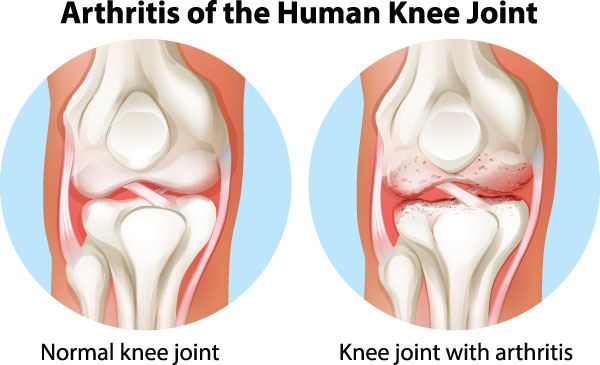Geniculate Artery Embolization
The Interventional Radiologists at MRA specialize in cutting edge procedures to treat joint pain in the knee and elsewhere.
What is osteoarthritis?
Osteoarthritis is degeneration of the joint cartilage and underlying bone. Because it is a ‘wear and tear’ disease, it often develops slowly and worsens over time. Signs and symptoms include pain, stiffness, loss of motion, and swelling. It is usually diagnosed through a combination of clinical history, physical exam and x-ray findings.
It is generally not possible to reverse the joint damage in osteoarthritis, and so initial treatment focuses on slowing progression and managing symptoms. Maintaining a healthy weight and staying active with low-impact exercise are very important in this regard. Medications such as Tylenol and NSAIDs (for example ibuprofen) can often provide temporary relief of pain associated with osteoarthritis. Injection of steroids or hyaluronic acid into the joint can also provide relief, although this too is usually temporary. If these conservative measures failed, historically there were few other treatments options aside from surgical joint replacement. Recently, a new non-surgical treatment option has emerged.
Geniculate Artery Embolization is a new, safe, and highly effective treatment for improving pain associated with osteoarthritis, without the need for surgery.
Geniculate artery embolization involves reducing the abnormal blood supply (hypervascularity) of the diseased joint, specifically within the joint lining called the ‘synovium’. The inflamed synovium is thought to contribute to much of the pain in osteoarthritis. The procedure begins by introducing a catheter (a thin, flexible tube) into the blood vessels through a tiny incision in the groin. Real-time imaging (X-ray or CT) is used to guide the catheter to the arteries of the knee, where tiny particles are then injected which block the abnormal blood vessels which have developed as a result of the osteoarthritis.
Most patients go home the same day, with only a Band-Aid. They may take over-the-counter medicines for discomfort over the next few days. Because the procedure is minimally invasive, the pain and recovery time are far less than with surgery.
Most patients begin to experience relief within two weeks. In the largest U.S. study to-date evaluating GAE, average pain scores decreased from 8 out of 10 before GAE, to 3 out of 10 after GAE. After one year, most patients still reported a reduction in pain scores of more than 50%. It was also extremely safe, with very few reported complications.
Geniculate artery embolization for hemarthrosis
GAE is also highly effective in the treatment of bleeding into the knee joint (hemarthrosis), especially following joint replacement. In fact, this was the initial application of the technique before it was adapted for the treatment of osteoarthritis.
Embolization for frozen shoulder (adhesive capsulitis)
Embolization has also been shown to be highly effective in the treatment of frozen shoulder (adhesive capsulitis). This is probably because much of the pain and inflammation in frozen shoulder is due to abnormal blood vessels that line the synovium. Traditionally, anti-inflammatory medications and physical therapy were the only treatment options for this disease, but this is no longer the case. Multiple studies have shown impressive improvements in pain and range of motion following embolization (arterial embolization of the shoulder, AES).
GAE is typically covered by insurance. Your out-of-pocket expense will depend on your specific insurance plan.
Request a consultation today:
One of our expert Interventional Radiologists will personally review your case with you, and discuss whether Geniculate Artery Embolization is the right option for you.
Patients, please note that services may require a referral from your primary care or another provider, but we can help facilitate that process if treatment is deemed necessary. Telehealth consultations may be available depending on the type of procedure required.


